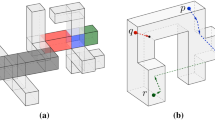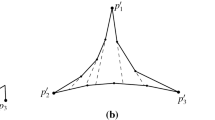Abstract
A point q is embraced by a set of points S if q is interior to the convex hull of S [8]. In some illumination applications where points of S are lights and q is a point to be illuminated, the embracing concept is related to a good illumination [4, 6], also known as the ∆-guarding [12] and the well-covering [10]. In this paper, we are not only interested in convex dependency (which is actually the embracing notion) but also in proximity. Suppose that the sites of S are lights or antennas with limited range; due to their limited power, they cover a disk of a given radius r centered at the sites of S. Only the points lying in such disks are illuminated. If we want to embrace the point q with the minimum range r, we need to know which is the closest light s q to q such that q lies in the convex hull formed by s q and the lights of S closer to q than s q . This subset of S related to point q is called the closest embracing set for q in relation to S and its cardinality is the closest embracing number of q. By assigning every point q in the convex hull of S to its closest embracing site s q , we obtain a partition of the convex hull that we call the embracing Voronoi diagram of S. This paper proves some properties of the embracing Voronoi diagrams and describes algorithms to compute such diagrams, as well as the levels in which the convex hull is decomposed regarding the closest embracing number.
Similar content being viewed by others
References
M. Abellanas, A. Bajuelos, G. Hernández, and I. Matos, “Good illumination with limited visibility,” In: Proc. of the International Conference of Numerical Analysis and Applied Mathematics, Wiley-VCH Verlag (2005), pp. 35–38.
M. Abellanas, A. Bajuelos, G. Hernández, I. Matos, and B. Palop, “Minimum illumination range voronoi diagrams,” In: Proc. of the 2nd International Symposium on Voronoi Diagrams in Science and Engineering (2005), pp. 231–238.
M. Abellanas, A. Bajuelos, and I. Matos, “Some problems related to good illumination,” In: O. Gervasi and M. Gavrilova (eds): Proc. of ICCSA 2007, LNCS 4705, Springer-Verlag (2007), pp. 1–14.
M. Abellanas, S. Canales, and G. Hernández, Buena Iluminación, Actas de las IV Jornadas de Matematica Discreta y Algorítmica, Madrid 2004, pp. 236–246.
T. Asano, S. K. Ghosh, and T. C. Shermer, “Visibility in the plane,” In: J.-R. Sack and J. Urrutia (eds.): Handbook of Computational Geometry, Elsevier, Amsterdam (2000), pp. 829–876.
S. Canales, “Métodos Heurísticos en problemas geométricos,” Visibilidad, Iluminación y Vigilancia, PhD Thesis, Universidad Politécnica de Madrid, (2004).
M. Y. Chan, D. Chen, F. Y. L. Chin, and C. A. Wang, “Construction of the nearest neighbor embracing graph of a point set,” J. Comb. Optim., 11, No. 4, 435–443 (2006).
S. N. Chiu and I. S. Molchanov, “A new graph related to the directions of nearest neighbors in a point process,” Adv. Appl. Probab., 35, No. 1, 47–55 (2003).
H. Edelsbrunner, “Algorithms in combinatorial geometry,” Edited by W. Brauer, G. Rozenberg, and A. Salomaa, Springer-Verlag, New York Inc. (1987).
A. Efrat, S. Har-Peled, and J. S. B. Mitchell, “Approximation algorithms for two optimal location problems in sensor networks,” In: Proc. of International Conference on Broadband Networks, Vol. 1 (2005), pp. 714–723.
S. K. Ghosh, Visibility Algorithms in the Plane, Cambridge University Press, Cambridge (2007).
J. Smith and W. Evans, “Triangle guarding,” In: Proc. of the 15th Canadian Conference on Computational Geometry (2003), pp. 76–80.
J. Urrutia, “Art gallery and illumination problems,” In: Handbook of Computational Geometry, Edited by in J.-R. Sack and J. Urrutia, Elsevier (2000), pp. 973–1027.
Author information
Authors and Affiliations
Corresponding author
Additional information
Translated from Sovremennaya Matematika i Ee Prilozheniya (Contemporary Mathematics and Its Applications), Vol. 63, Optimal Control, 2009.
Rights and permissions
About this article
Cite this article
Abellanas, M., Hernández, G., Bajuelos, A.L. et al. The embracing Voronoi diagram and closest embracing number. J Math Sci 161, 909–918 (2009). https://doi.org/10.1007/s10958-009-9610-0
Published:
Issue Date:
DOI: https://doi.org/10.1007/s10958-009-9610-0




